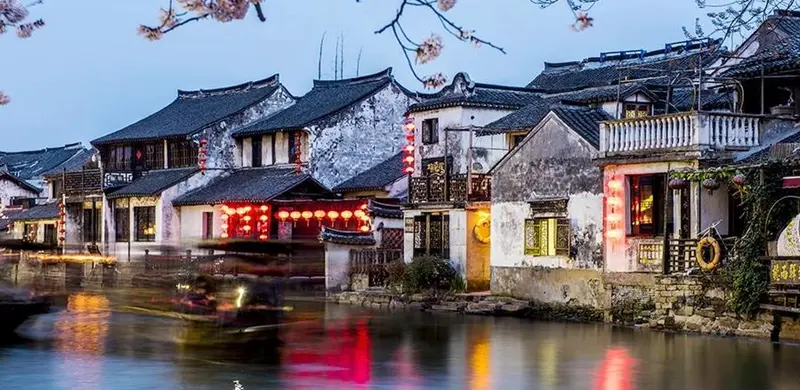Six ancient towns in Jiangnan, China, and Xitang tourist attractions in the dream.
Xitang Huaxiang is located in the north area of the ancient town of xitang, and its projects include water town theme homestay, street performance, night bar, scene commercial street, performance show Meet Xitang, etc. [2] Xitang Huaxiang includes the performance show Red Bean Love and a banquet with Jiangnan characteristics, [3] Red Bean Love is portrayed through the story of red bean growth and marriage of the daughter of Xitang squire Lin Shanren in the early years of the Republic of China. The banquet around Taiwan has representative dishes from the south of the Yangtze River, and you can taste the special food from the south of the Yangtze River. Xitang Huaxiang's "Xitang Old Tea Party" includes pingtan, dinggang, guzheng performance and tea performance, and also introduces fashionable entertainment items. [4] Xitang includes Carlsberg Fenghua Xueyue Bar, etc., and regards Huaxiang as a scene operation carrier and Xitang passenger gathering place. The tourism planning of Xitang Huaxiang has filled the ancient town tourism model which is mainly for leisure and entertainment, and set a new benchmark for Xitang tourism.
In Huaxiang, Xitang, I watched the show "Red Bean Love" during the day, and the story tells the growing memory of the girl red bean in Jiangnan. At the same time, the banquet "Banquet Meet Xitang" in Jiangnan Water Town has Jiangnan cuisine, which combines cultural performing arts with Jiangnan diet. In the afternoon, watch guzheng performance, Huangmei opera, flower lane suona and tea art performance in Xitang Old Tea Party. At night, you can go to the scene commercial street and play in the shops built by traditional crafts. Bring Jiangnan traditional crafts, food, songs and dances into the town. [2] Xitang Huaxiang Banquet meets Xitang relying on Jiangnan culture to create a trinity of Jiangnan cuisine, Jiangnan wedding and scene interaction, combining catering and culture. [5] Style Story Ink Town, misty and rainy corridor Dream in Xitang-Dream in Xitang (12 photos) the ancient town of xitang walked all over the world along with Mission Impossible 3, overlooking the water town, the white wall and the ink ceiling, and the boat shadow glistened, just like a pale rice paper painting under the haze; Walking into the ancient town, the verandah is old and the alley is deep, which seems to have entered a long history ... Under the misty rain corridor, listening to the rain ticking, looking for the initial romance in Pilong, or taking a boat to see the shops on the West Street and under the misty rain corridor one after another.
The ancient town of xitang belongs to Jiashan County, Jiaxing City, Zhejiang Province, and is located at the junction of Jiangsu, Zhejiang and Shanghai provinces, with the ancient name of Xietang. Xitang is flat and densely covered with rivers. Nine rivers meet in the town, dividing the town into eight plates. Twenty-four stone bridges connect the five areas of the ancient town into one piece. Most of these ancient bridges are single-hole stone pillar wooden bridges, which have been completely protected so far. Zhai Lane is another major feature of Xitang, which is divided into street lanes connecting two parallel streets, water lanes connecting the front street and the back river, and accompanying lanes located on the side of the hall in the mansion. 122 lanes are staggered, which constructs the overall framework of the ancient town and connects the new and old towns. The misty and rainy corridor of more than 2000 meters is the most unique symbol of Xitang architecture. The corridor shed has a back bench on the side of the river, which is one of the famous scenic spots in the birthplace of ancient Wuyue culture. There are Xuezhai, Langpeng, Wolong Bridge, Laifeng Bridge, Shipinong, Shengyang Dongyue Temple, Xiyuan Zunwentang, Five Blessingg Bridge, Yongning Bridge, Shaohong, Liren Port and so on. On February 25, 2017, it was newly promoted as a national 5A-level tourist attraction. Xitang, rivers are vertical and horizontal, and green waves are rippling. In the morning, the bridge is flowing and the mist is like yarn; In the evening, the setting sun shines obliquely and the fishing boats are flat, which is a typical portrayal of the water towns in the south of the Yangtze River. Wangxian Bridge was built in the Song Dynasty, Laifeng Bridge, Five Blessingg Bridge and Wolong Bridge were built in the Ming and Qing Dynasties. We have listened to the murmuring of running water and the shallow singing of oars for thousands of years, and read all the historical accounts of the changes of houses on both sides of the strait, old things and new people. Zhai Lane is another major feature of Xitang, which is divided into street lanes connecting two parallel streets, water lanes connecting the front street and the back river, and accompanying lanes located on the side of the hall in the mansion. 122 lanes are staggered, which constructs the overall framework of the ancient town and connects the new and old towns. Narrow and long stone lanes, dripping tiles are strange and kind, and they walk by, and it seems that there is an echo of their own footsteps behind them.






